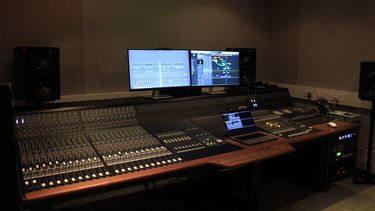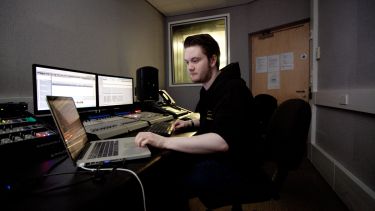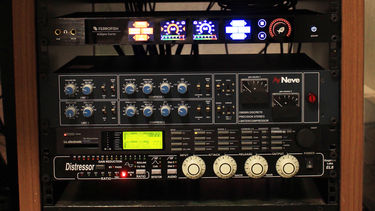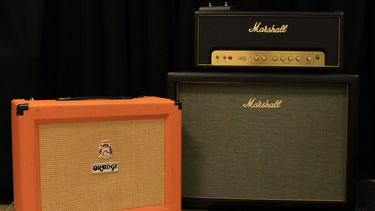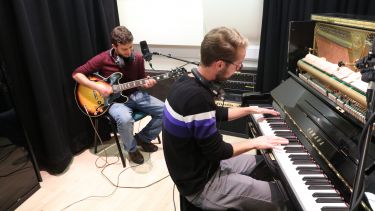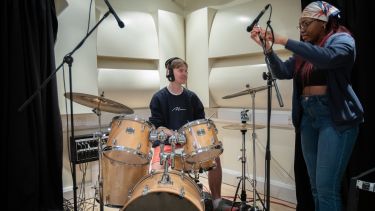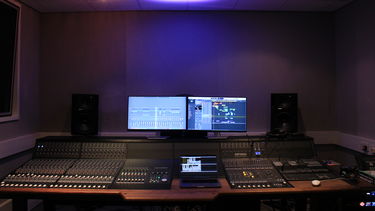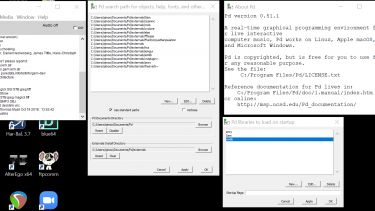Equipment and tools
Information about the facilities and tools available within the Sound Studios.

Equipment
USSS comprises six studios with a wide range of hardware and software for use in composition, sound recording, production, editing, design and performance.
Studio hardware and resources
The USSS has a wide collection of microphones from leading brands such as Neumann, DPA, AKG, SE, Shure, AudioTechnica and Sennheiser.
The six studios are designed with different approaches to sound creation in mind:
USSS 1 Large Control Room
- Audient ASP8024HE 24 channel analogue console with patchbay and Dual Layer Control (DLC)
- Mac M2 Studio Max
- Neve 33609/N stereo limiter/compressor
- Empirical Labs EL8 Distressor compressor
- Ferrofish A32Pro Dante audio interface
- Audient ORIA Immersive audio interface and monitor controller
- Stereo, 5.1 and 8 channel Genelec monitoring
USSS 2 Large Live Room
- Live room variable acoustic
- Marshall Origin 50 Head & Origin 2x12 cabinet
- Orange CR60 amplifier
- Ampeg SVT-7 Pro bass head and Pro Neo 410HLF cabinet
- Yamaha Stage Custom drum kit with Sabian AAX cymbals
USSS 3 Stereo Composition and Playback Room
- Mac Mini M2 Pro
- RME Fireface UCX
- Genelec monitoring
USSS 4 Surround Sound Composition and Playback Room
- Mac Mini M2 Pro
- RME Fireface UFX
- Genelec 5.1 monitoring
USSS 5 Stereo Control Room
- Mac Mini M2 Pro
- RME Fireface UC
- SSL Control Surface
- Octopre microphone preamps
- Genelec stereo monitoring
USSS 6 Foley Studio and Live Room
- Foley pits and materials
- TV with connection to USSS 1
- Upright Piano
Software
- Logic Pro
- Sibelius
- PureData and USSS Tools
- Reaper
- GRM Tools
- Adobe Creative Suite
- Supercollider
- Csound
Concert sound system
The USSS Sound Junction concert system is a 32-channel 3-dimensional diffusion system with custom software and hardware. The majority of the 32 loudspeakers are Genelec (10*8040A, 1032, 1031, 8030, 7070subs). Playback is from a dedicated PC running the SuperDiffuse software (written by James Surgenor in Supercollider) through a control voltage fader-box. Audio interfaces are MADI RME (MADIface and M32DA).
The development of the concert sound system has been made possible by the generosity of alumni and staff through contributions to the University’s Alumni Fund.
USSS Tools
USSS Tools are designed and maintained by Professor Adrian Moore to aid the composition of electroacoustic music in PureData.
Sonic Art: An Introduction to Electroacoustic Music Composition
Adrian Moore (2016). University of Sheffield Sound Studios. A tutorial book for all students of sonic art contextualising a number of toolkits made at the sound studios. Published by Routledge.
The toolkit requires additional libraires to be installed using Deken (pd>help>find externals)
Sonic Art: An introduction to electroacoustic music composition. Download a brief example from chapter 2 explaining some of the ussstools. This free-to-view chapter is from a very early edition of the text. Many new updates including multi-channel tools have been added to the book.
Although there is no accompanying CD, the vast majority of the audio examples used come from the Empreintes DIGITALes streaming site.
USSS tools with Mac M1/M2
The ussstoolskit should work with the following installed from Deken (find externals):
- cyclone
- else
- freeverb~
- Gem
- hcs
- iemgui
- iemlib
- zexy
- lyonpotpourri
In addition, if you want to use the spectral shaping tool 'shapee' you'll need to download and manually extract into your externals folder the fftease package from Eric Lyon's github. You may need to get entangled with your computer's security settings to allow these to run.
Using USSS tools with Pure Data Vanilla (Windows)
Such are the developments in Pure Data that it's best to get the latest pd and then install the libraries from the list below via Deken (Help>find externals). You have to be a little careful to find the right version.
This screen capture shows the external libraries required to run the USSS tools. Click on the picture to get a fuller view. The central box is file>preferences>path - you may need to add all of these manually but do it once and it's done for ever. The box on the far right at the bottom is file>preferences>startup. This is also necessary.
- Gem
- ceammc
- creb
- cyclone
- else
- fftease
- hcs
- iemgui
- iemlib
- vstplugin~
- zexy
- freeverb~
These were all downloaded by using Deken BUT be super careful to get the right set for your OS and 64/32bit etc. If you are running into problems, do give me an email (a.j.moore@shef.ac.uk).
Short video clips supporting the USSS tools
- Welcome and Introduction
- Playing soundfiles using usss.output and usss.sfplay
- Playing soundfiles and varying the speed (and the pitch)
- Recording your results into a soundfile
- Basic Granulation
- Finding the right sound for the job
- A more complex example
- USSS phasorsynth demonstration - polyphonic synths with midi keyboard
- Pulsing a granulation sound - adding pulse to a sustained sound
- Polyphonic MIDI sampler - Using the keyboard to change the pitch of a loaded soundfile
- Texture generation - developing the MIDI sampler using notes in a table instead of the keyboard
- Colouring one soundfile by another using fftease shapee - mapping the spectral qualities of one soundfile (predominantly steady-state) onto another (predominantly full-spectrum articulated)
- Playing multi-channel soundfiles using the N channel player - using one object to play files with any number of channels (and introducing the combplayer to colour output)
- A quirky 'gate'
- A basic polyphonic synth - a very simple synth unit playing sine, triangle, square, sawtooth and pulse waves
- A spectral delay
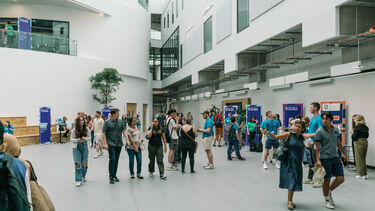
Experience Sheffield for yourself
The best way to find out what studying at Sheffield is like is to visit us. You'll get a feel for the atmosphere, the people, the campus and the city.

